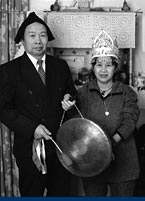Film
Abstract
Between Two Worlds:
The Hmong Shaman in America
"This classic film documents the Hmong refugees who have been transplanted from their agrarian mountain villages in northern Laos to cities in the U.S. Often living in high-rise tenements, they bring their ancient shamanic rituals and ceremonies to urban America. In such unlikely settings, trance-like healing and animal offerings are practiced as they were back home."
"The documentary captures rare and dramatic footage of the Hmong buying and sacrificing a cow in rural Illinois to save a sick baby in a metropolitan hospital. It shows the attempts of a missionary to convert a traditional Hmong family. It also explores an unexplained phenomenon (SUNDS) in which young Hmong men have died in their sleep for no apparent medical cause. Anthropologist Dwight Conquergood, well-known for his work with the Hmong, points out the similarity between their beliefs and those of the Native Americans." -- Filmmakers Library: Multiculture
Winner, UCLA Film Folklore Fest., 1986
Silver Plaque, Chicago International Film & Video Festival, 1985
Merit Award, Athens International Film & Video Festival, 1985
Film
Abstract
The Split Horn:
Life of a Hmong Shaman in America
"THE SPLIT HORN is the sweeping story of a Hmong shaman and his family living in Appleton, Wisconsin. Documenting the 17-year journey of Paja Thao and his family from the mountains of Laos to the heartland of America, this poignant film shows a shaman's struggles to maintain his ancient traditions as his children embrace American culture."
"The Hmong (mung) are an Asian tribal culture. After fighting valiantly for the United States in the Vietnam War, many Hmong like the Thao family were forced to flee their homeland in Southeast Asia. Since 1975, over 200,000 Hmong refugees have resettled in the U.S."
"For over 17 years since the family arrived in America, filmmaker Taggart Siegel has chronicled the intimate and private lives of Paja Thao, his wife and their 13 children. THE SPLIT HORN focuses on Paja, a shaman whose spiritual leadership plays a vital role in Appleton's Hmong community. He ministers to the physical and spiritual needs of friends and family with elaborate rituals that bridge the natural and spirit worlds. As his children grow up, however, they are losing touch with their father's ancient traditions. In a pivotal scene, Paja, wearing a black veil, dances on a wooden bench, shaking and chanting in an ecstatic trance. Across the room, three of his children lounge on the sofa, transfixed by The Simpsons and MTV, ignoring the ancient spirit battle played out by their father."
"Chai, the shaman's 12-year-old daughter, is caught between the richly traditional world of her parents and the complicated life of a typical American teenager. As the film's narrator, Chai shows viewers the collision of cultures taking place in her house and in the Hmong-American community."
"A year of sadness leads Paja to conduct a ceremony for his family during which he discovers that his own soul has strayed from his body. He spirals into a depression, unable to heal himself or others. The community, worried by Paja's depression, asks two shaman friends to lead a healing ceremony for him. The Thao children come together, putting aside their religious differences to support their father and mother. One of the older sons, Koualy, returns to Hmong tradition after 14 years and helps his father with the ceremony. Paja beams with joy and renewed strength."
"THE SPLIT HORN, which can be watched in the Hmong language on SAP (Secondary Audio Program), captures the daily struggle of a family caught between two worlds and examines the intergenerational rift between immigrant parents desperate to maintain their ancient traditions while their children embrace American lifestyles." -- PBS
The Split Horn: The life of a Hmong Shaman in America / Alchemy Films; produced in association with the Independent Television Service and NAATA; produced by Taggart Siegel, Jim McSilver, Sarita Siegel; directed by Taggart Siegel; written and adapted from interviews by Jim McSilver and Taggart Siegel." -- UMD Library
"Describes the art of Shamanism and the role of the Shaman in Hmong society. Examines conflict between the ancient religion and traditions of the Hmong and Christian practice and belief. Interviews Hmong living in Chicago." -- UMD Library











